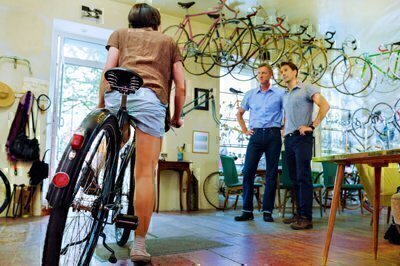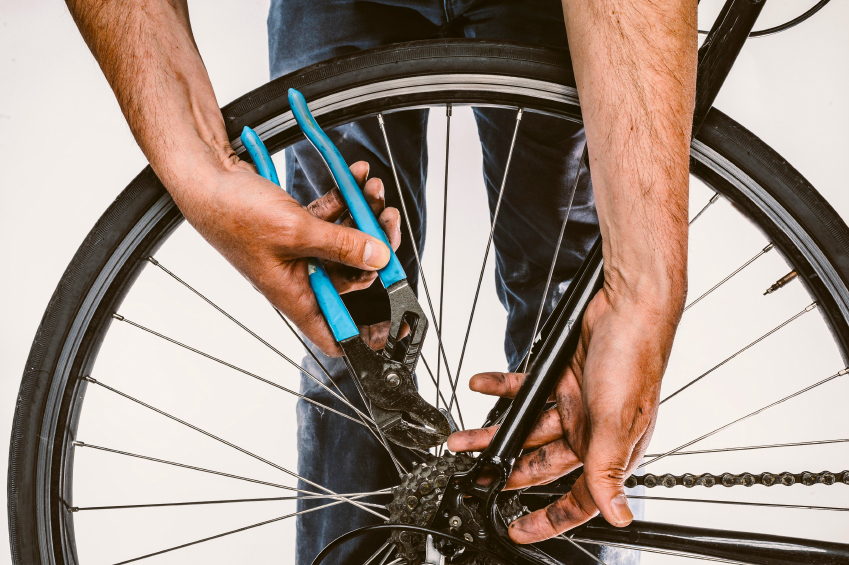Last updated May 2023
 Bikes aren’t just for weekend rides and recreation anymore. Dedicated bicycle lanes, two-wheel-friendly public transit, and a push toward greener lifestyles mean residents are increasingly likely to pedal to work or to run errands.
Bikes aren’t just for weekend rides and recreation anymore. Dedicated bicycle lanes, two-wheel-friendly public transit, and a push toward greener lifestyles mean residents are increasingly likely to pedal to work or to run errands.
But with so many choices—road, hybrid, mountain—it’s hard to know how to get rolling. A good bike shop can help you choose, and we’ve got ratings of local outlets. Plus, if you already own a bicycle, we’ve also got ratings of repair services to get you on the road (or trail) again.
Which Bike Would You Like?
Bike models come in a range of styles: mountain, road, commuter, touring, cruisers, folding, electric assist—although many models mix and match features of several types.
To narrow your choices, think about how you will use your wheels. Will you run errands, commute, work out, compete? How often will you ride? Every day, weekends only, hardly ever? What kind of surface will you roll on? Smooth roads, potholed city streets, off-road trails? How hilly will the terrain be? Do you have a need for speed?
In general, the more you plan to ride and compete, the more you’ll pay.
This guide to bike types might help, but you’ll need to acquire hands-on experience, too, so visit shops, try friends’ wheels, or rent bikes.
Road Bikes
Road bikes have tires that are often less than an inch wide and pumped to a very high pressure, drop (“ram’s horn”) handlebars, ultra-lightweight construction, narrow seats, and a wide range of gear ratio combinations. Built for high speed and crisp handling, road bikes cover a lot of ground fast on commutes, day rides, or races.
A road bike requires careful tuning and maintenance; expensive versions are extremely high-tech precision machines—some cost more than $10,000, although most riders will find good-enough options for far less.
For some, the bent-over riding position, seat configuration, frame design, and narrow tires make for an extremely uncomfortable ride. Plus, the riding position and quick steering response discourage casual sightseeing, and the narrow tires and lightweight precision construction aren’t suitable for rough terrain.
Touring Bikes
These models look a lot like road bikes but are designed for long trips. Compared to road bikes, the tires are a bit wider, the tubes to which handlebars and seat are attached are less upright, the distance between seat and handlebars is shorter, and the distance between front and back wheels is longer.
These differences produce a comfier, more stable ride than a road bike via a more upright riding position and easier steering. Touring bikes have different gear ratios than road bikes, with more gears at the low end for uphill rides. Within the touring category, you are likely to find a single “compromise” bike suitable for reasonably high-speed daytrips and commutes, but also serviceable for multiday treks with heavy packs—most touring bikes are equipped to add a range of racks for carrying duffel bags, camping equipment, coolers, etc. If you’re considering a touring bike, also consider commuter bike options (see below).
 Mountain Bikes
Mountain Bikes
Mountain bikes have chunky, sturdy frames; wide high-traction tires; flat or riser handlebars; suspensions to lessen jarring from bumps; and at least 18—and possibly 30 or more—gear ratios extending into very low ranges. This combo yields bikes that can be ridden off-road on rugged up-and-down terrain. Some mountain bike styles are designed specifically for cross-country, downhill, and extreme-terrain riding.
Hybrid/Commuter Bikes
Most hybrid (also called “commuter” and “city”) bikes are mashups of features from mountain and road bikes. They’re less rugged than mountain bikes, with smoother, narrower tires for easier pedaling on road surfaces but can’t be pedaled as efficiently as road bikes. Like mountain bikes, city bikes offer an upright riding position and have shock-absorbent construction—making them preferred by commuters and day-trippers.
Cruisers
At the opposite extreme from road bikes are cruisers. Direct descendants of 1930s, ’40s, and ’50s models, they have fat tires, upright handlebars, large seats, and, often, coaster brakes (applied by pushing down on the back pedal). Cruisers are ideal for comfortable, leisurely riding and sightseeing on level terrain. They are simply constructed, easy to maintain, and durable but aren’t very good for climbing hills or traveling quickly.
Mashups
Many models borrow some features from two or more types of bike designs. For example, taking drop handlebars and narrower tires from the road bike category and rugged frame, high pedal clearance, and shocks from mountain bikes.
Electrics
Just about all bike types listed above are available as e-bikes. Most aren’t fully electric; they’re “electric assist,” with small motors to help you make it up hills or complete longer rides.
The big drawbacks are cost and weight. Even entry-level models cost thousands of dollars, and some cost $5,000+. Many e-bikers sign up for bike-sharing services, instead of owning.
Even More Designs
You’ll find plenty of other kinds of bikes, too, including folding models, three-speed bikes, and “BMX” and freestyle/trick bikes. Fixed-gear bikes (aka track bikes) are similar to road bikes but with only one gear combination. Plus, the bike industry is always shifting gears and coming out with new options.
Materials and Features
Bike construction materials and features can impact performance, comfort, and durability. The best way to get a feel for what’s available is to visit several bike shops for advice and test rides, but here are a few major considerations:
Frame
The central—and usually most expensive—component of a bike is its frame. Frames should be lightweight, durable, and rigid, and should dampen road or trail vibrations. Depending on what they’re made of and how they’re made, there is tremendous variation in frame quality.
The least-expensive bicycles—generally sold in discount stores and other outlets that don’t specialize in bikes—are made with steel. These basic models tend to be very heavy (around 35 to 45 pounds) but cheap (sometimes under $100).
Many lower-middle and mid-priced bikes are made with aluminum frames, which are not as strong as steel but are much lighter.
Some high-end road and mountain bike models are crafted of light, durable, and strong titanium, which flexes so well while maintaining its shape that it can be incorporated into designs that allow the metal itself to act as a shock absorber. All these benefits come with a high price tag.
The ultimate frame material is carbon fiber, formed from strands of light, strong metal fibers bound together with resin. This creates very tough, very light, very expensive bike frames.
Which frame to choose? Among the different materials, there is no outright winner. Extremely high-quality frames can be made from carbon fiber, titanium, aluminum, and even high-quality steel. The keys to making the best choice are aligning the bike’s cost and quality with your riding preferences.
Rims and Tires
After the frame, wheels are a bike’s most important components. They can be made of many types of metals, with similar tradeoffs among weight, strength, performance, and price.
Tires should let you expend as little energy as possible as you pedal. The less tire surface meeting the road, the less friction. Hard tires with slick treads require less energy than soft tires with “nubby” treads. This means you’ll travel fastest with the least effort on narrow, hard, low-tread tires. However, these skinny models are the least comfortable, least durable, and least protective of rims, and provide the least traction on rough terrain.
The most expensive tires are very light and have high pressure ratings. This lets you accelerate relatively easily because the tire has low rotating mass and loses relatively little energy in flexing the sidewalls of the tire. Still, they’re more easily punctured and provide less traction and rougher rides over bumpy terrain than heavier tires.
Gears
To limit their fatigue and physical stress, cyclists try to maintain a constant pedaling rate. This is best accomplished with multi-geared models instead of one- or three-speed bikes. It’s easier to pedal in lower gears and harder to pedal in higher gears, but the range of gears helps you adjust to terrain and achieve higher speeds. So as you shop, consider what you’ll be using your wheels for—and then make sure your new bike has the gears to match.
Other Features
Bikes can also come with multiple other bells and whistles: comfy, gel-padded seats; quick-release levers (good for quick adjustment with changing terrain on off-road bikes); pedals with toe-clips or clipless attachment mechanisms to increase pedaling efficiency; handlebar width and type. You can learn more about what to look for by visiting cycling websites, talking with other cyclists, and hitting the bike store for advice and in-person snooping.
Getting Outfitted
A good bike shop can provide immense help selecting and maintaining your wheels.
Getting Advice on What to Buy
Our Ratings Tables report how area outlets were rated by area consumers. We surveyed mostly Checkbook subscribers, but also invited other randomly selected consumers to provide ratings. Click here for further description of our customer survey and other research methods.
Our surveys asked respondents to rate shops for sales service on questions such as “advice on choice and use of products,” “promptness of service,” “staff attitudes/atmosphere,” “ease of looking at/testing products,” “reliability,” and “overall quality.” Our Ratings Tables show the percent of each store’s customers who rated it “superior” (as opposed to “adequate” or “inferior”).
As you can see, there were substantial differences in ratings. Because prices for new bicycles do not vary much, if at all, from seller to seller (see below), you may as well focus your shopping on stores that employ staff who offer excellent advice.
 Get a Proper Fit
Get a Proper Fit
The best bike shops will help you select the right sized bike and then adjust it for an ideal fit. Here are some guidelines:
Straddle the frame to check its size. The rule of thumb is that bikes that will be used only on roads should have one or two inches of clearance between the top tube and the rider’s crotch; the clearance for off-road bikes should be three or four inches or more.
Check the position and height of the seat by placing the bike in a stand and then observing your legs as you move the pedals. For most riders, it’s best to have the seat set so that the lower part of the leg is vertical when the front pedal is halfway up. Generally, saddle height should not permit the thigh to come up to horizontal at the top of the pedal stroke and should allow the leg to be just slightly bent at the bottom of the stroke when pedaling.
Check your reach. Recreational riders should not feel too bent over. To ride for speed, you should be able to lean farther forward, with your weight closer to the center of the bike; but your arms should still be relaxed and your body shouldn’t feel overly stretched.
Check the position and width of the handlebars. Although riders should be able to raise them at least as high as the seat, speed-oriented riders usually want to set them lower. Handlebar width should correspond to shoulder width.
Always Try Before You Buy
Don’t buy a bike until you’ve tested several models at several price ranges—you may find a great ride for less than you expected. Even experienced riders need to get some perspective on the current market, which offers much better bikes than were available at similar prices just a few years ago.
For each bike, have a salesperson fit you properly. Then observe carefully the smoothness of the ride, the bike’s responsiveness, how comfortable your body feels, the bike’s stability, and how easy it is to control, shift, and brake. Tell the salespeople what you like and dislike, and let them make adjustments or suggest another bike.
Getting a Good Build and Adjustments
Bike retailers are responsible for final assembly and adjustment. When bikes arrive from the factory, some components are not yet attached, and others are just that—attached. If shop mechanics do no more than slap on the remaining parts, the bike won’t work: Brake pads might not contact rims, for example, and you might not be able to shift into all the gears.
Any shop will assemble and adjust the bike so you can ride out using all the gears; that typically takes about 45 minutes. But a great shop will do much more—possibly spending two to four hours on assembly.
 While our ratings don’t specifically identify shops that do the best preparation work, Table 2 shows ratings of repair work by surveyed customers. Several shops were rated “superior” for “doing work properly” by at least 90 percent of their surveyed repair-work customers. Because most shops use the same mechanics to assemble bikes as to repair them, it’s reasonable to assume that shops with high-quality repair operations are good prospects for top-quality bike preparation.
While our ratings don’t specifically identify shops that do the best preparation work, Table 2 shows ratings of repair work by surveyed customers. Several shops were rated “superior” for “doing work properly” by at least 90 percent of their surveyed repair-work customers. Because most shops use the same mechanics to assemble bikes as to repair them, it’s reasonable to assume that shops with high-quality repair operations are good prospects for top-quality bike preparation.
Almost all bike shops offer a period of free adjustments after sales. Many offer free adjustments for the life of the bicycle, while others limit them to one year, six months, or less.
There’s Little Price Variation for New Bikes
Unlike most retail businesses, prices for new bicycles change little from store to store, and you won’t find big savings by buying online. Because bike manufacturers maintain strict pricing controls over retailers, our undercover shoppers found that even a $25 difference for major name brands is rare.
Especially since there’s no price advantage to buying bikes online, we strongly recommend purchasing from a local shop for the expertise of their salespeople and mechanics for fitting and adjustments. Because major manufacturers don’t allow online-only stores to sell bikes, even if you do buy online you’ll just end up getting redirected to a local store for purchase and assembly. (For example, if you select and buy a bike on Trek’s website, your sale will be finalized by one of its local dealers.)
On the other hand, the market for bike components and accessories—ranging from handlebars to clothing to car-top carriers—is less stringent, with some stores charging half as much as their competition for a particular item. You’ll find even lower prices for accessories online.

Getting Reliable Repairs
Unfortunately, even the perfect bike requires occasional repairs and tune-ups. The customer survey ratings on our Ratings Tables can point you to a good repair shop.
To make sure you don’t get taken for a ride, our Ratings Tables also provide repair service price comparison scores. These scores show how each shop’s prices for four jobs compared to the average prices of all surveyed shops. The scores are adjusted to a base of $100. This means a shop with a price comparison score of $110 had prices 10 percent higher than the average of all shops’ prices for the same jobs.
As indicated on the table below, although you won’t find big shop-to-shop price differences for new-bike sales, you will find very big price differences if you need repairs.


